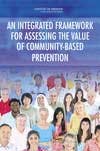Community-based prevention for dental hygiene
Over the past century the major causes of morbidity and mortality in the United States have shifted from those related to communicable diseases to those due to chronic diseases. Just as the major causes of morbidity and mortality have changed, so too has understanding of health and what makes people healthy or ill.
Research has documented the importance of the social determinants of health (for example, socioeconomic status and education), which affect health directly as well as through their impact on other health determinants such as risk factors. Targeting interventions toward the conditions associated with today’s challenges to living a healthy life requires an increased emphasis on the factors that affect the current causes of morbidity and mortality, factors such as the social determinants of health. Many community-based prevention interventions target such conditions.
The Centers for Disease Control and Prevention (CDC) has a new report that provides updated statistics on Population Prevalence of Periodontal Disease in U.S. Adults. This report, entitled “Prevalence of Periodontitis in Adults in the United States: 2009 and 2010,” concludes that 47.2% of U.S. adults have some form of periodontal disease. Previous population estimates of the disease may have underestimated its true population prevalence. Read the report here.(5)
There is also a new data brief: Oral Health Disparities as Determined by Selected Healthy People 2020 Oral Health Objectives for the United States, 2009–2010. The Healthy People 2020 initiative contains over 1,200 objectives that serve as a roadmap for tracking the nation's health. An important activity of Healthy People is to monitor health disparities in the United States, which include indicators like poverty status, race, and ethnicity. This new data brief focuses on key Healthy People Oral Health objectives covering select age groups by race, ethnicity, and poverty status from 2009 to 2010. Read the data brief at NCHS Data Brief 104.(6)
When we speak about prevention, community-based prevention interventions offer three distinct strengths.
First, because the intervention is implemented population-wide it is inclusive and not dependent on access to the health care system. Second, by directing strategies at an entire population an intervention can reach individuals at all levels of risk. And finally, some lifestyle and behavioral risk factors are shaped by conditions not under an individual’s control.
For example, encouraging an individual to eat healthy food when none is accessible undermines the potential for successful behavioral change. Community-based prevention interventions can be designed to affect environmental and social conditions that are out of the reach of clinical services. When a person is ill, making a case for policies and programs to avoid further deterioration of health or death seems reasonable. However, prevention requires that before someone becomes sick, society invest the financial and other resources necessary to make the required changes in individual and community life associated with preventing illness.
Some of the persons who receive the intervention would never become sick, yet they share the costs of the intervention. These certain costs of improving health often outweigh the perceived benefits of community-based prevention, especially if individuals perceive their own risk of illness as low.
Four foundations—the California Endowment, the de Beaumont Foundation, the W.K. Kellogg Foundation, and the Robert Wood Johnson Foundation—asked the Institute of Medicine to convene an expert committee to develop a framework for assessing the value of community-based, non-clinical prevention policies and wellness strategies, especially those targeting the prevention of long-term, chronic diseases.
The charge to the committee was further defined as follows:
• Define “community-based, non-clinical prevention policy and wellness strategies.”
• Define “value” for community-based, non-clinical prevention policy and wellness strategies.
• Analyze current frameworks used to assess the value of community based, non-clinical prevention policies and wellness strategies. This includes:
o the methodologies and measures used and
o the short- and long-term impacts of such prevention policy and wellness strategies on communities, including health care spending and public health.
• If warranted, propose a new framework or frameworks that capture the breadth and complexity of community-based, non-clinical prevention policies and wellness strategies, including interventions that target specific behaviors and health outcomes.
The framework should:
• consider the sources of data that are needed and available;
• consider the concepts of generalization, scaling up, and sustainability of programs; and
• address national and state policy implications associated with implementing the framework.
This PDF is available from The National Academies Press.(7)
One of the first tasks facing the committee was defining the terms related to its charge. The phrase “community-based, non-clinical prevention policy and wellness strategies” appears in the Statement of Task. This phrase has been shortened for purposes of the report to community-based prevention.
The committee concluded that community-based prevention interventions are population-based interventions that are aimed at preventing the onset of disease, stopping or slowing the progress of disease, reducing or eliminating the negative consequences of disease, increasing healthful behaviors that result in improvements in health and well-being, or decreasing disparities that result in an inequitable distribution of health.
The committee also concluded that, in addition to a focus on population health, community-based prevention interventions also may address changes in the social and physical environment, involve intersectoral action, highlight community participation and empowerment, emphasize context, or include a systems approach.
The term community, for purposes of the report, means any group of people who share geographic space, interests, goals, or history.(8) The value of an intervention, for purposes of the report, is defined as its benefits minus its harms and costs.(8) This is a 181-page report, but well worth reading for anyone involved in community prevention efforts.




